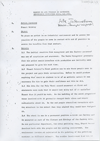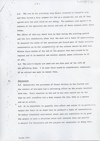

Transcript
REPORT ON APG PROJECT AT HAVERHILL
COMMENCING SEPTEMBER 1970 – MAY 1971
1. Artist Involved
Stuart Brisley
2. Object
To place an artist in an industrial environment and to assess the reaction of the people he cam in contact with and if possible to assess the benefits from that contact.
3. Details
3.1 The initial reaction from management and the factory personnel was one of skepticism and amusement. The Works Management generally felt the artist would interfere with production and initially were not prepared to give him much time.
3.2 Stuart Brisleys first problem was to win these people over to the project and gain their co-operation. Before he could produce anything that could be claimed to be of an artistic nature it was necessary for him to gain their confidence and this he did.
3.3 His idea for the Poly Wheel caused amusement at first and statements were made that it would look silly but if it satisfied Stuart then it would be made. As the building of the wheel progressed those involved with it gradually changed their views and became enthusiastic about it. In the end people identified themselves with the structure to the extent that they claimed they could have designed it.
3.4 The wheel is now in a permanent position outside the factory and is accepted as part of the fixture and fittings of the factory site. In one particular department, the metal polishing shop, Stuart became involved both with the people and the working environment. The environmental involvement culminated in the painting of the polishing machines in different colours. The emotive involvement lead him to produce personal notice boards.
3.5 The men in the polishing shop became involved in Stuart’s work and they formed a deep respect or him as a person but not all of them agreed with the work which he was doing. The machines were painted to colours of the operators own choice and some of these colours still exist today.
The effect of this was short term in that during the painting period and the time immediately after that the work was a topic of conversation. It occupied the minds of the operators and formed part of their everyday conversation as to the acceptability of the colours chosen by each man. Within three months of the end of the project this had ceased to be topical and it is doubtful now whether anybody makes reference to it at all.
3.5 The notice boards are used and now form part o the life of the polishing shop. I am sure there would be considerable resistance if an attempt were made to remove them.
4. Conclusion
4.1 Undoubtedly the presence of Stuart Brisley in the factory and the results of his work had a refreshing effect on the people involved with him. Their reaction to him and to his work varied but by the time he left everybody had a deep respect for him, both as a person and as an artist.
4.2 It is impossible to quantify this effect and relate it to production output but there is no doubt that he produced a topic of conversation. In today’s industrial environment where jobs are repetitive it is good for people to have situation which will interest them and provide a subject for discussion and the project was successful in doing this.
March 1973